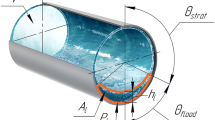Abstract
The heat transfer phenomenon occurring during stratified condensation inside an inclined tube is investigated theoretically and numerically. Differential equations governing the kinematic, dynamic, and thermal aspects for vapor condensation inside inclined tubes, which are derived from a thin film flow modeling, are solved simultaneously. These solutions are achieved by applying an explicit finite difference numerical method to predict the condensation heat transfer coefficient variations along the tangential and axial coordinates. The inclination angle is found to have a significant effect on condensation heat transfer coefficient inside inclined tubes. In addition, in accordance with the given physical and thermal condition of working fluids, there is a specific optimum inclination angle. In this study, the 30°–50° range from the horizontal position is found to be the range of the optimum inclination angle for achieving the maximum condensation heat transfer coefficient, with R134a, R141b, and R11 as the working fluids. The results of the present study are compared with experimental data, and a good agreement is observed between them.
Similar content being viewed by others
References
H. D. Baehr and K. Stephan, Heat and mass transfer, Springer, Berlin, Germany (2006).
S. M. Ghiaasiaan, Two-phase flow, boiling and condensation in conventional and miniature systems, Cambridge University Press, New York, USA (2008).
J. G. Collier and J. R. Thome, Convective boiling and condensation, Oxford University Press, Oxford, UK (1996).
A. Cavallini, G. Censi, D. D. Col, L. Doretti, G. A. Longo, L. Rossetto and C. Zilio, Condensation inside and outside smooth and enhanced tubes — a review of recent research. International Journal of Refrigeration, 26(4) (2003) 373–392.
A. S. Dalkilic and S. Wongwises, Intensive literature review of condensation inside smooth and enhanced tubes. International Journal of Heat and Mass Transfer, 52(15, 16) (2009) 3409–3426.
H. S. Wang and J. W. Rose, Film Condensation in Microchannels: Effect of Tube Inclination. Proceedings of the 4th International Conference on Nanochannels, Microchannels and Minichannels, ASME, Limerick, Ireland, CD, paper ICNMM2006-96049 (2006).
T. Nitheanandan and H. M. Soliman, Influence of tube inclination on the flow regime boundaries of condensing steam. Canadian Journal of Chemical Engineering, 71(1) (1993) 35–41.
G. P. Fieg, Calculation of laminar film condensation in/on inclined elliptical tubes. International Journal of Heat and Mass Transfer, 37(4) (1994) 619–624.
H. M. S. Hussein, M. A. Mohamad and A. S. El-Asfouri, Theoretical analysis of laminar-film condensation heat transfer inside inclined wickless heat pipes flat-plate solar collector. Renewable Energy, 23(3, 4) (2001) 525–535.
K. Han, S. Yee, S. Park, S. Lee and D. Cho, A study on the improvement of heat transfer performance in low temperature closed thermosyphon. KSME International Journal, 16(9) (2002) 1102–1111.
D. Cho and K. Han, Influence of the inclination angle and liquid charge ratio on the condensation in closed two-phase thermosyphons with axial internal low-fins. KSME International Journal, 17(3) (2003) 422–428.
A. Bejan, Convection Heat Transfer, John Wiley and Sons, New York, USA (2004).
S. Chen, J. Reed and L. Tien, Reflux condensation in a two-phase closed thermosyphon. International Journal of Heat and Mass Transfer, 27(9) (1984) 1587–1594.
J. S. Lioumbas, S. V. Paras and A. J. Karabelas, Co-current stratified gas-liquid downflow—Influence of the liquid flow field on interfacial structure. International Journal of Multiphase Flow, 31(8) (2005) 869–896.
J. C. Y. Wang and M. Yiwei, Condensation heat transfer inside vertical and inclined thermosyphons. Journal of heat transfer, 113 (1991) 777–780.
W. Nusselt, Die Ooberflachen-Kondensation des Waserdampfes. Zeitschr. V.D.I. 60 (1916) 541–569.
Author information
Authors and Affiliations
Corresponding author
Additional information
This paper was recommended for publication in revised form by Associate Editor Kwang-Hyun Bang
Hamid Saffari received his Ph.D. degree from Moscow Power Engineering Institute, Russia. Dr. Saffari is currently an Assistant Professor at the School of Mechanical Engineering at Iran University of Science and Technology. His research interests include two-phase flow and HVAC&R.
Rights and permissions
About this article
Cite this article
Saffari, H., Naziri, V. Theoretical modeling and numerical solution of stratified condensation in inclined tubes. J Mech Sci Technol 24, 2587–2596 (2010). https://doi.org/10.1007/s12206-010-0916-0
Received:
Revised:
Accepted:
Published:
Issue Date:
DOI: https://doi.org/10.1007/s12206-010-0916-0




